This post may contain affiliate links. Please read our disclosure for more info.
What is the first thing that comes to mind when you think of yoga? Is it a peaceful and meditative yogi sitting on her meditation cushion? Or is it a strong and sweaty student moving with breath through grounded and challenging postures? If your idea of yoga is one that is athletic, powerful, and fiery, then Power Yoga may be just the right fit for you. A 20-minute beginner Power Yoga routine may be the perfect addition to your health and wellness routine.
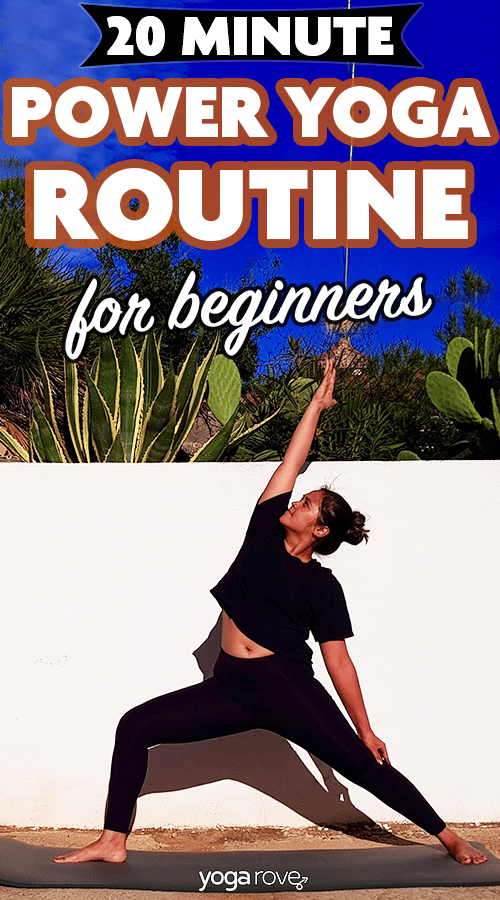
What is Power Yoga?
With its roots in Ashtanga Yoga, Power Yoga is a challenging yoga practice that incorporates vinyasa flows, moving with the breath, core work, and balance and stability poses. Power Yoga classes will leave you feeling sweaty, invigorated, and strong.
A fairly newer practice, Power Yoga was birthed in the West and marries the traditional Indian practice with fitness and athleticism. Popular all across the country, the practice can feel vigorous and challenging and very much like a workout. The practice builds your strength and stamina, builds up a sweat, and tones your muscles. In addition to the emotional and energetic benefits, many people practice power yoga to get stronger, lose weight, and strengthen their core.
Can Anyone Practice Power Yoga?
Although it may be a challenging practice, Power Yoga is accessible for every level of yogi. If you are new to yoga and are thinking of starting a Power Yoga practice, know that there are modifications that you can always take during class and that your strength, endurance, and flexibility will build with practice.
It is a great idea to start slowly and begin to build a steady and consistent practice with a class 1-2 times per week, or a 20-minute beginner Power Yoga routine from home every few days.
Is Power Yoga a Good Workout?
A Power Yoga practice is a great workout for the mind and the body. You receive all the mental and emotional benefits of a yoga practice including stress relief, mindfulness, and relaxation, as well as all the physical benefits of a vigorous and energizing workout. In a Power Yoga class, you will practice yoga poses that you may already be familiar with. However, you are likely to practice them at a faster pace than a classical Hatha class.
During a Power Yoga class, many poses are linked with a vinyasa and you will move with your breath. Additionally, there may be some portions of the practice in which you hold the poses a little longer to build muscular strength, balance, and stability. This athletic and active movement paired with strength building and challenging balancing postures make for a solid and dynamic workout.
Benefits of Practicing Power Yoga
The benefits of Power Yoga are endless. From feeling physically stronger to feeling more mentally calm, it is no wonder this style of yoga is so popular with yogis around the world. If you are starting power yoga with the intention purely for its physical benefits, you will likely begin to feel the more emotional, spiritual, and mental benefits of the practice as well.
Power Yoga:
- Builds strength and stability: Flowing through multiple rounds of vinyasa in a Power Yoga practice allows you to build strength from the inside out.
- Increases your stamina: A fast-moving practice, you feel yourself becoming stronger and more able to keep up with other physical activities that you may do.
- Burns calories: Because of its dynamic movement, many yogis practice power yoga to help with maintaining or losing weight.
- Tones your body: The dynamic movements of power yoga allow for your body to be toned, leaving you with longer and leaner muscles.
- Strengthens your core: Power Yoga requires a strong core and with time you will notice your core getting stronger and more engaged.
- Relieves stress and helps to release tension: That post-savasana feeling after your yoga practice stays with you and you are able to find yourself feeling less stressed and more relaxed during stressful situations.
- Improves your balance and concentration: As you flow through poses that require you to balance on one or both feet, you will start to build your concentration and your balance.
- Increases your flexibility: As with any yoga practice, the postures open up your body and increase your overall flexibility.
- Increases body awareness: Yoga allows you to become more in tune with your body and your breath. You may start to make healthier choices for yourself on and off of your mat.
- Allows you to be more present and mindful: While the physical benefits of yoga are wonderful, the changes that you feel within are even more powerful. Yoga teaches us the power of the present moment and helps us to be more mindful of our thoughts, feelings, and emotions.
20 Minute Beginner Power Yoga Routine
You can practice this 20-minute beginner Power Yoga routine in your living room, while traveling, or during your lunch break at work. All you need is yourself, a mat, and possibly a yoga block if you would like to use one. Modify your poses as needed and always listen to your body.
Take your time while flowing through the sequence, and don’t worry if it is a little challenging to synchronize your breath with your movement. With time and consistent practice, you will see your stamina, strength, and flexibility increase. Focus on strengthening your muscles, keeping your core engaged, and connecting to your breath as you practice.
Warm-Up
To begin to build strength and stability and to connect to the breath, we will begin with a short movement sequence that synchronizes breath and movement. Every posture is linked with an inhale or exhale.
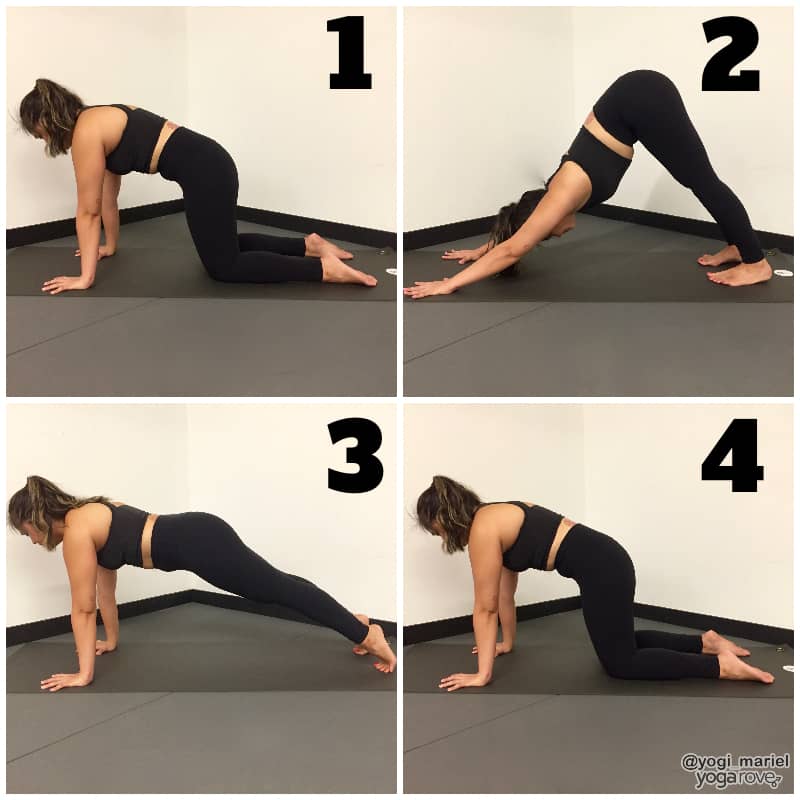
- Start in a tabletop position and begin on your hands and knees. Check that your hands are underneath your shoulders and your knees are underneath your hips. Spread your fingers wide on the mat and draw your belly button in towards your spine.
- Inhale to arch your back and look up for cow pose. Stick your tailbone up towards the ceiling and feel your shoulder blades gently squeeze down your back.
- Exhale into downward facing dog. Lift your hips up and your knees off of the mat. Push the mat away to feel length in your spine and your side body.
- Inhale to come forward to plank pose. Your body should be in a straight line with your hands under your shoulders, heels lifted, and legs strong.
- Exhale to take the knees back down to the floor into a tabletop position.
- Repeat the sequence of postures with your breath 5 times. At the end of your fifth round, make your way back to downward facing dog.
First Flow
This flow will help to warm up the body, fire up your core, and get you moving with your breath.

-
- From downward dog, step to the top of your mat and bring your feet together. On your next inhale, rise up to standing and bring your hands to your heart center.
- Inhale to an upward salute by lifting your arms up over your head.
- Exhale to fold forward and take your forehead to your shins.
- Inhale to step your right foot back to a low lunge. Exhale to step your left foot back to downward dog.
- Inhale to roll forward to high plank pose.
- Exhale to take your seat to your heels and head and palms on the mat. Keep your toes curled under. This pose is like childs pose, except the toes stay curled and the arms stay straight with elbows off the mat.
- Inhale to come back to plank pose.
- Exhale to downward dog.
- Inhale to lift your right leg up in a down dog split. Keep your hips squared, toes flexed, and leg straight. As you exhale, take your knee to your right elbow. Inhale to lift back to down dog split, exhale to take your knee to your left elbow. Inhale once more to down dog split, and exhale to bring your knee to your nose.
- Look forward and step your right foot forward in between your hands. Step your left foot forward and fold into a forward fold.
- Inhale to halfway lift. Exhale to fold.
- Inhale to rise back up to stand and exhale back into mountain pose.
- Repeat this on the left side.
Second Flow
This second flow moves into strong warrior poses. Take this sequence through twice — the first time, hold each warrior for 3-5 breaths, and the second time around take the sequence through moving one breath per movement.

-
- Bend your knees and sit your hips down low as you take your arms up high for chair pose.
- Exhale to fold forward.
- Inhale for a halfway lift.
- Exhale to step back to plank pose. Inhale in plank and as you exhale, lower your knees, chest, and chin down, or lower halfway for chaturanga.
- Inhale into upward facing dog or baby cobra.
- Exhale to downward dog.
- Inhale your right leg up into a down dog split.
- Exhale to take your knee to your nose before you step your foot forward in between your hands.
- Root your back heel flat on the mat and rise up to Warrior 1. Square our hips to the front of the room, bend into your front knee and keep your arms strong as you lift your upper body out of your waist. Take 3-5 full breaths in Warrior 1.
- Straighten your right leg and turn your toes to face the left as you turn your left toes to face the back of the room. Open into Warrior 2 facing the back of the room. In Warrior 2, bend into your left knee, keep your arms strong, your upper body in the center, and your back heel rooting down to the ground. Look over your left fingertips and stay for 3-5 breaths.
- On your next inhale, turn your left toes to point the same direction as your right toes and raise your arms up overhead for Flying Warrior. Keep your legs straight and strong and all 10 toes pointing forward. Your arms are strong and shoulders relaxed.
- As you exhale, turn your right toes forward to face the front of the room for Warrior 2 on the right side. Stay for 3-5 full breaths.
- Reach your right arm forward, back, and up for Peaceful Warrior. Feel your right side body stretch and keep your left hand light on your left thigh. Keep the bend in your front knee and your back leg strong and rooted.
- As you exhale, plant your palms flat on the floor and frame your right foot. Spin your back heel up toward the ceiling and square your hips forward for a low lunge.
- Step your right foot back into plank pose and take your vinyasa.
- Repeat on the left side and then take the same sequence through again, this time moving one breath per movement.
Standing Poses
Triangle and Half Moon Pose are held for a few breaths and build balance and strength in your body. Feel free to use a block for more stability in your poses.
Triangle Pose
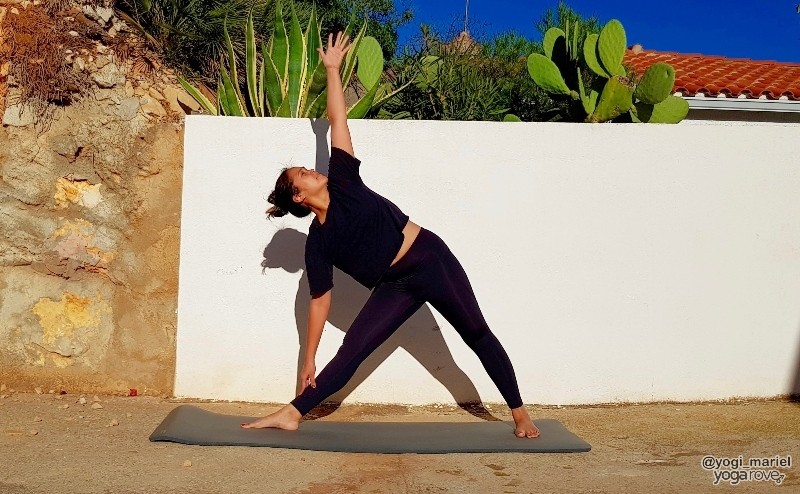
- From downward dog, walk your hands back to your feet and slowly round your body up to stand.
- Turn to face the left side of the room and take your feet together.
- Step your right foot out to the right and take a very wide stance. Check that your wrists are above your ankles and that all 10 toes are pointing in the same direction.
- Turn your right toes to face the front of the room. Take your arms out parallel to the floor. Engage your thigh muscles and keep your legs strong.
- Reach forward with your right fingertips while keeping your legs strong. When you can’t reach anymore, place your right hand lightly on your shin, ankle, or block. Reach your left hand up to towards the ceiling at 12 o’clock. Hold our triangle pose for 5 full breaths.
Half Moon Pose
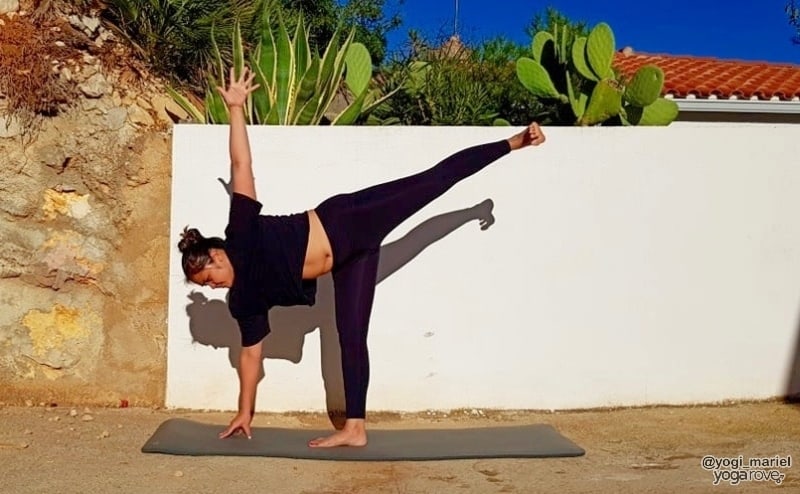
- At the end of your 5th breath, look down at your mat and bend your right knee. Walk your fingertips forward right in front of your right toes. Feel free to place your hand on a block for more height.
- Begin to shift your weight to your right leg and slowly start to lift your left leg up.
- Flex your left toes and roll your left hip on top of your right hip, while opening up your body to the left side of the room.
- Keep your left hand on your hip, or straighten your arm and reach your fingertips up towards the ceiling. Roll your left shoulder open and lengthen through the crown of your head.
- Lastly, you can shift your gaze up to your fingertips or keep gazing down at your mat. Stay for 5 full breaths.
- At the end of your 5th breath, slowly step back to Warrior 2. Stay for 1 breath to ground
- Straighten your right leg and turn your right toes inward. Turn your left toes to point to the back of the room and keep both of your legs straight.
- Make your way into Triangle pose and then Half Moon Pose on your left side.
Core and Cool Down
Fire up your core before cooling down and finding a nice, relaxing savasana.
Yoga Bicycle
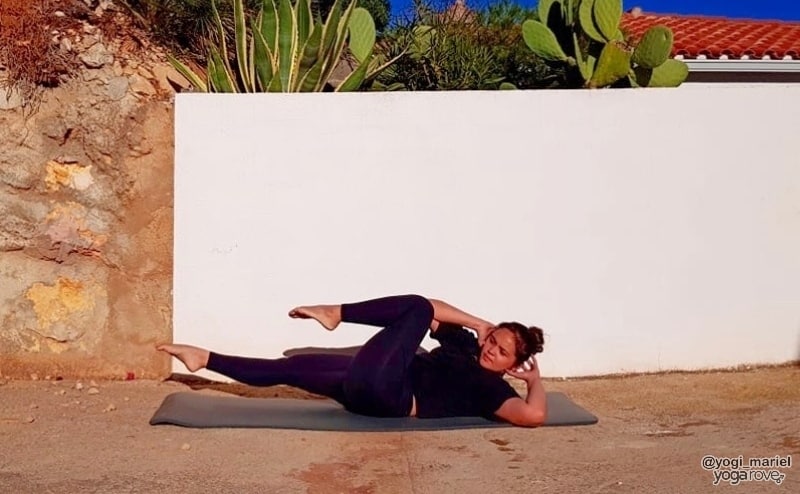
- Lie down on your mat, lift your feet off the mat and take your shins parallel to the floor.
- Lightly place your fingertips on your ears and open your elbows to the sides of the room. Keep your chest open and your collar broad.
- Inhale to lift your head and shoulders off the mat. Extend your left leg and hover the heel 2 inches from the floor. At the same time, take your left elbow to touch your right knee. Switch sides and take your right elbow to your left knee while keeping your right leg straight, hovering 2 inches off the floor.
- Repeat 10 cycles.
Supta Baddha Konasana
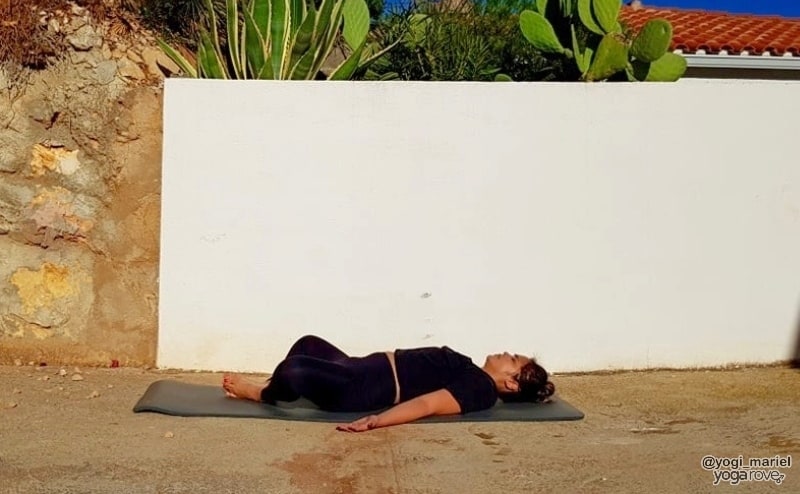
- Hug both of your knees into your chest.
- Take your legs down to the mat and bring the soles of your feet together to touch, while opening your knees to the sides of the room.
- Relax your arms alongside your body and stay for 5 deep breaths.
Savasana
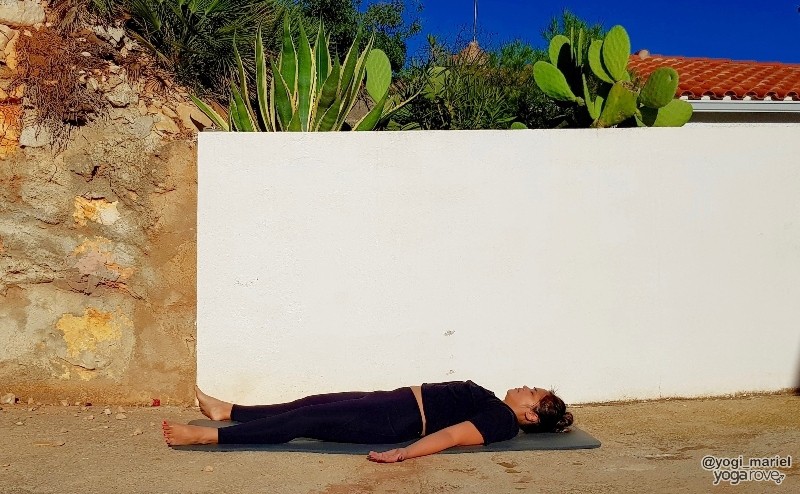
- Extend your legs straight out in front of you and relax your arms with your palms facing up to the sky.
- Close your eyes and relax your entire body for 2-3 minutes.
Power Yoga can be a challenging but rewarding and fun practice. If you are new to the practice, be patient with yourself, focus on your breath, and enjoy the journey. Take your time to familiarize yourself with new postures and the energizing movement, and you will be flowing through different sequences in no time!
Related Questions
What is Hot Power Yoga? Hot Power Yoga is the same type of dynamic practice as Power Yoga, but practiced in a heated room. This can add to the intensity of the practice and allows your muscles to stretch and open up more.
Can I practice Power Yoga every day? Some yogis do practice Power Yoga every day. However, it is important to listen to your body and give yourself what you need. While it is safe to practice every day, give yourself rest if you feel you need it or take a more restorative or relaxing practice.


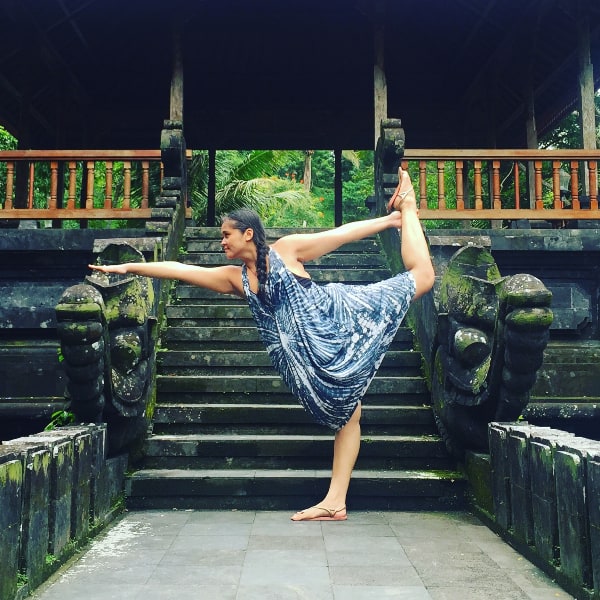
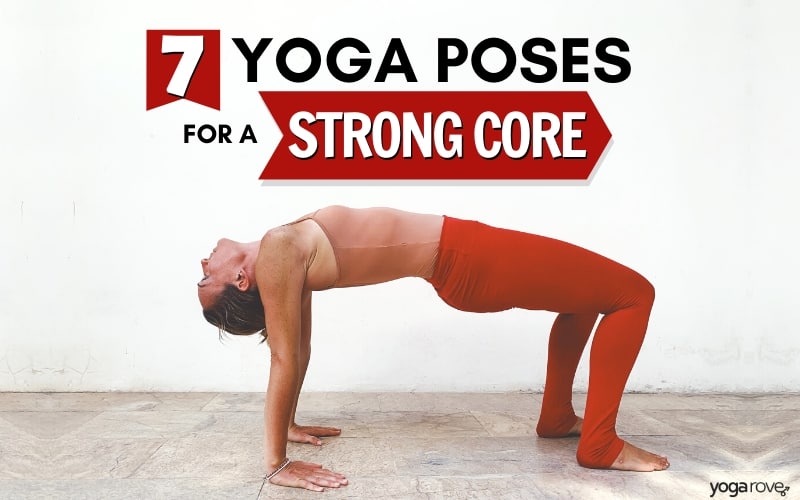
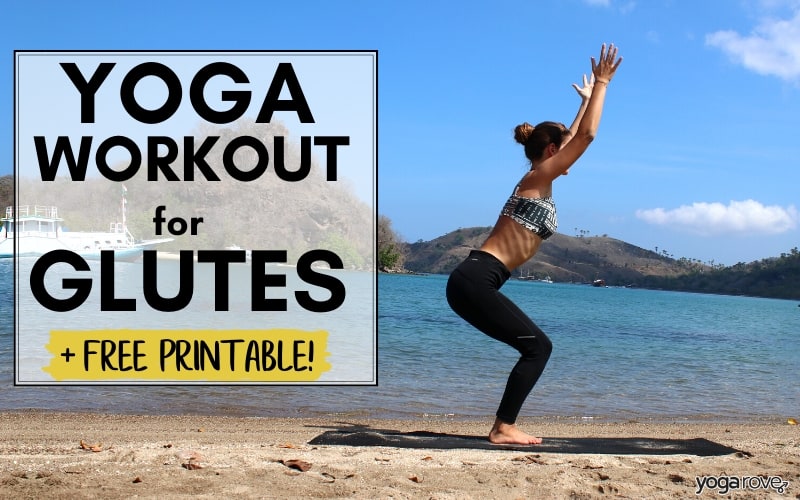
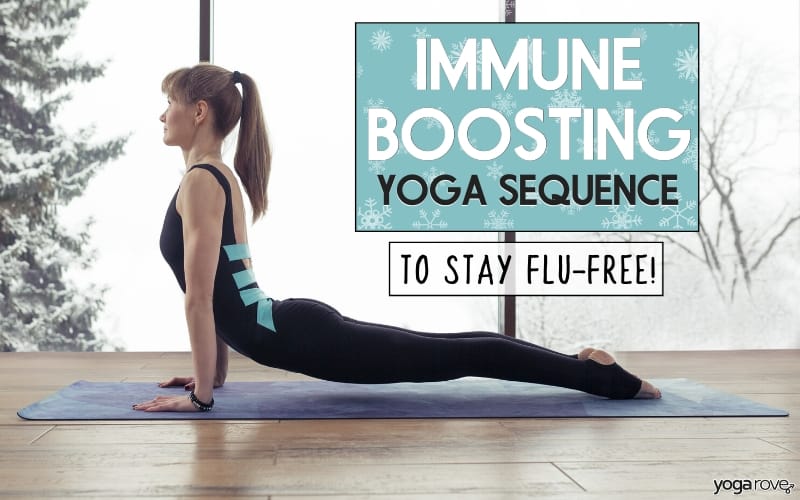
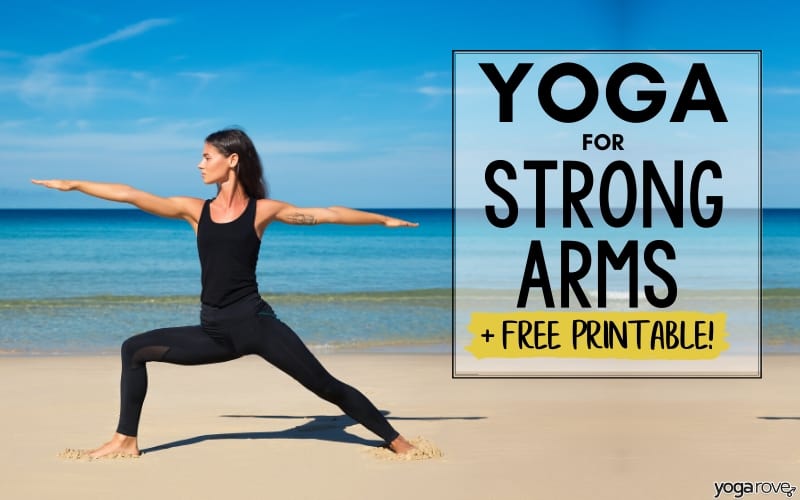
Is this available in a video to follow along with?
Not yet but we are working on it 🙂 Should have videos coming out soon!
Thank you so much for posting these sequences I find them to be incredibly helpful!
So happy to hear that Monica!
Very nice sequence to do everyday. Thanks for sharing. Since I teach Chair yoga to my senior adult population I ask, “ Can this poses be modified to chair yoga?”
Mrs Soni
Glad you enjoyed it! Yes most of the poses can definitely be modified for chair yoga! A few might need to be replaced with others but the majority can definitely be adapted. Check out our chair yoga article here for some ideas: https://yogarove.com/sitting-yoga-poses/
Amazing Power yoga routine from Rove.
And such generosity as they share this and so.much more!
Glad you enjoyed it Sandra!